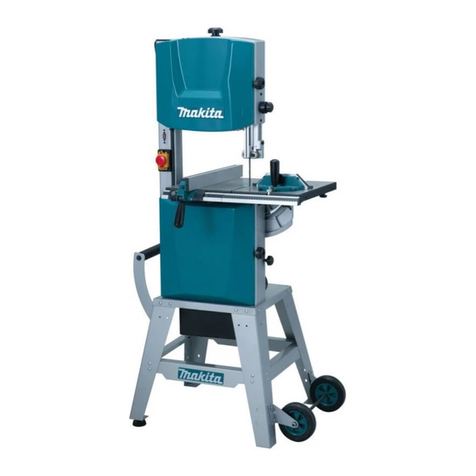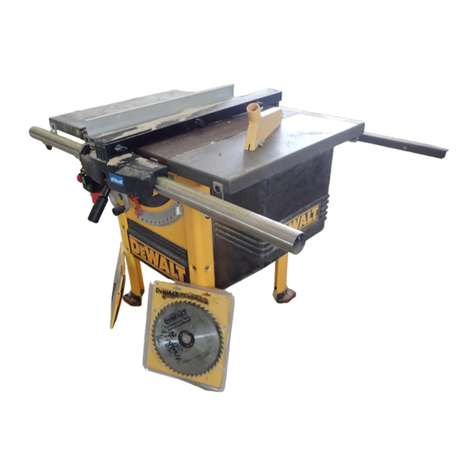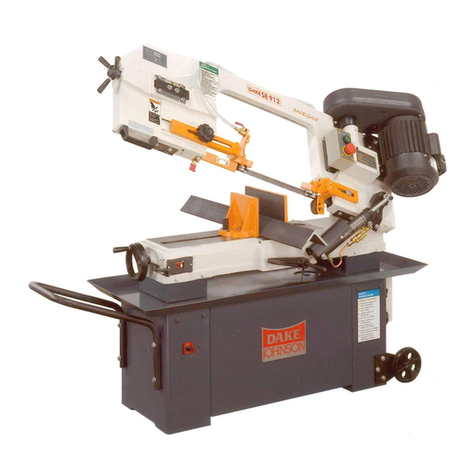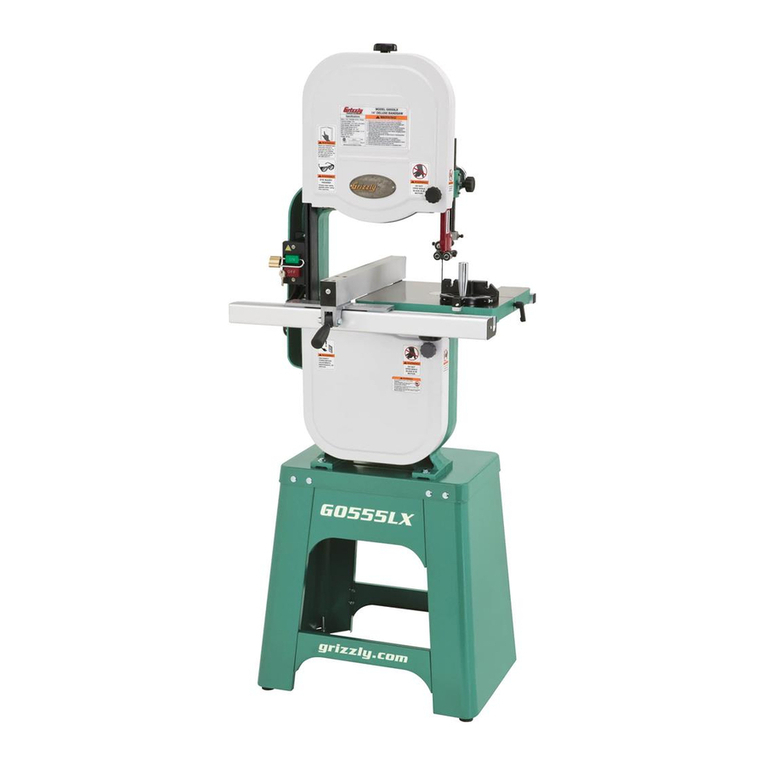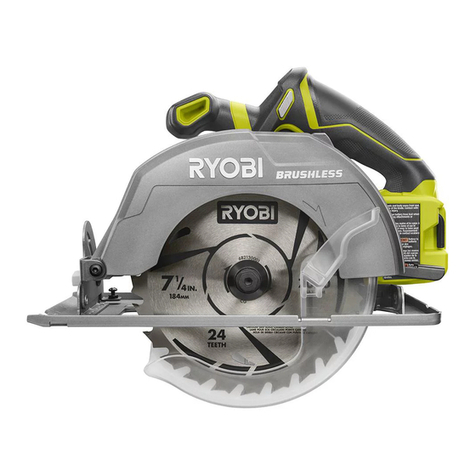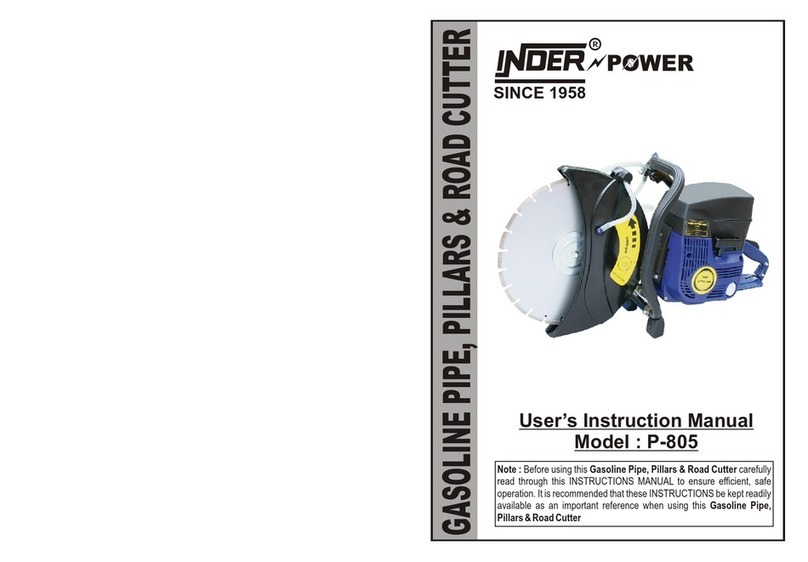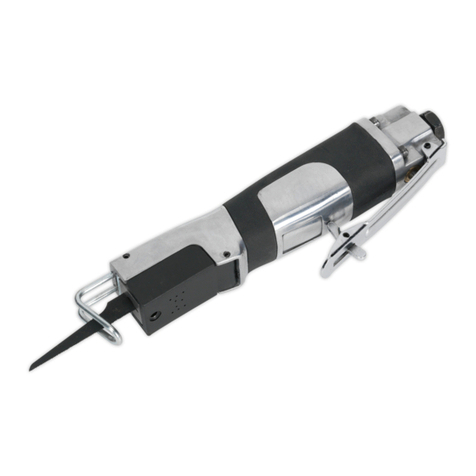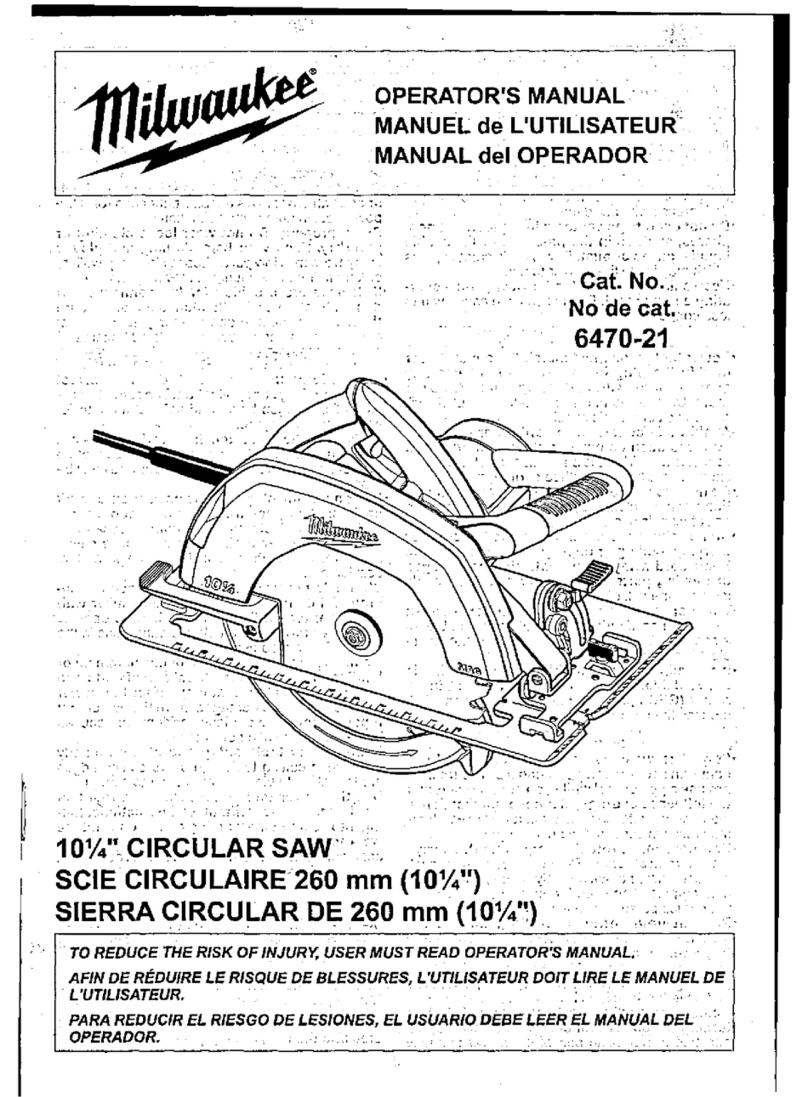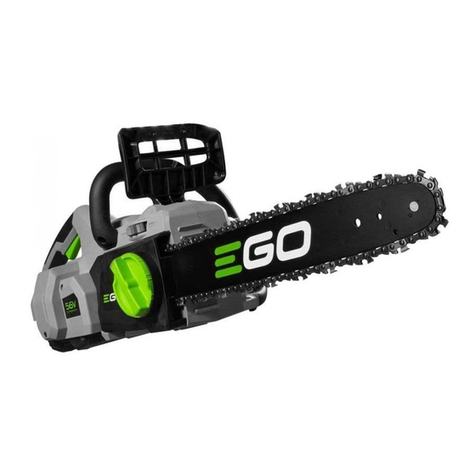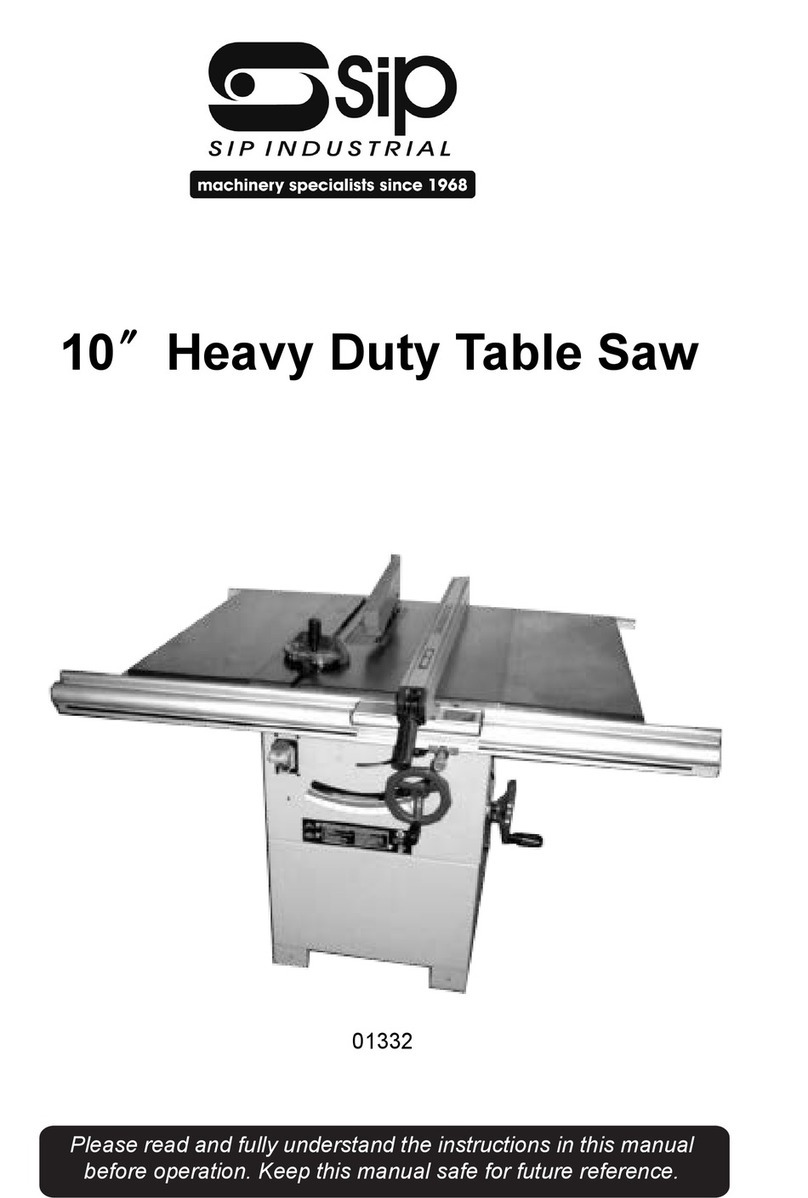Makita DLW140 User manual

DLW140
EN Cordless Portable Cut-off INSTRUCTION MANUAL 6
ID Pemotong Portabel Nirkabel PETUNJUK PENGGUNAAN 15
VI Máy Cắt Sắt Để Bàn Hoạt
Động Bằng Pin TÀI LIỆU HƯỚNG DẪN 26
TH 36

1
2
Fig.1
1
Fig.2
2
1
3
Fig.3
1
12
Fig.4
1
2
Fig.5
1
2
Fig.6
1
Fig.7
12
Fig.8
2

12
Fig.9
1
2
Fig.10
1
Fig.11
1
Fig.12
Fig.13
Fig.14
1
2
Fig.15
3

13
4
2
6
5
Fig.16
123
Fig.17
1
Fig.18
1
2
3
4
Fig.19
Fig.20
1 2 3
4
Fig.21
1
Fig.22
4

Fig.23
5

6ENGLISH
ENGLISH (Original instructions)
SPECIFICATIONS
Model: DLW140
Wheel diameter 355 mm
Hole diameter 25.4 mm
Max. wheel thickness 3 mm
No load speed 3,800 min-1
Rated voltage D.C. 36 V
Dimensions
(L x W x H)
With European type safety
guard
537 mm x 290 mm x 640 mm
With safety guard other
than European type
537 mm x 280 mm x 640 mm
With center cap type safety
guard
537 mm x 280 mm x 640 mm
Net weight With European type safety
guard
17.2 - 17.8 kg
With safety guard other
than European type
15.6 - 16.3 kg
With center cap type safety
guard
15.4 - 16.0 kg
• Duetoourcontinuingprogramofresearchanddevelopment,thespecicationshereinaresubjecttochange
without notice.
• Specicationsmaydifferfromcountrytocountry.
• Theweightmaydifferdependingontheattachment(s),includingthebatterycartridge.Thelightestandheavi-
estcombination,accordingtoEPTA-Procedure01/2014,areshowninthetable.
• Theshapeandweightvarydependingonthespecicationswhichdiffercountrytocountry.
Applicable battery cartridge and charger
Battery cartridge BL1815N/BL1820/BL1820B/BL1830/BL1830B/BL1840/
BL1840B/BL1850/BL1850B/BL1860B
Charger DC18RC/DC18RD/DC18RE/DC18SD/DC18SE/DC18SF
• Someofthebatterycartridgesandchargerslistedabovemaynotbeavailabledependingonyourregionof
residence.
WARNING: Only use the battery cartridges and chargers listed above.Useofanyotherbatterycartridges
andchargersmaycauseinjuryand/orre.
Symbols
Thefollowingshowthesymbolsusedfortheequip-
ment.Besurethatyouunderstandtheirmeaningbefore
use.
Wear safety glasses.
Read instruction manual.
Ni-MH
Li-ion
Only for EU countries
Donotdisposeofelectricequipmentor
batterypacktogetherwithhousehold
wastematerial!Inobservanceofthe
European Directives, on Waste Electric
andElectronicEquipmentandBatteries
andAccumulatorsandWasteBatteriesand
Accumulatorsandtheirimplementation
in accordance with national laws, electric
equipmentandbatteriesandbattery
pack(s) that have reached the end of
theirlifemustbecollectedseparatelyand
returnedtoanenvironmentallycompatible
recycling facility.
Intended use
The tool is intended for cutting in ferrous materials with
appropriateabrasivecut-offwheel.Followalllawsand
regulations regarding dust and work area health and
safety in your country.

7ENGLISH
SAFETY WARNINGS
General power tool safety warnings
WARNING: Read all safety warnings, instruc-
tions, illustrations and specications provided
with this power tool.Failuretofollowallinstructions
listedbelowmayresultinelectricshock,reand/or
seriousinjury.
Save all warnings and instruc-
tions for future reference.
The term “power tool” in the warnings refers to your
mains-operated(corded)powertoolorbattery-operated
(cordless) power tool.
Work area safety
1. Keep work area clean and well lit. Cluttered or
dark areas invite accidents.
2. Do not operate power tools in explosive atmo-
spheres, such as in the presence of ammable
liquids, gases or dust.Powertoolscreatesparks
which may ignite the dust or fumes.
3. Keep children and bystanders away while
operating a power tool. Distractions can cause
you to lose control.
Electrical Safety
1. Power tool plugs must match the outlet. Never
modify the plug in any way. Do not use any
adapter plugs with earthed (grounded) power
tools. Unmodiedplugsandmatchingoutletswill
reduce risk of electric shock.
2. Avoid body contact with earthed or grounded
surfaces, such as pipes, radiators, ranges and
refrigerators. There is an increased risk of elec-
tricshockifyourbodyisearthedorgrounded.
3. Do not expose power tools to rain or wet con-
ditions. Water entering a power tool will increase
the risk of electric shock.
4. Do not abuse the cord. Never use the cord for
carrying, pulling or unplugging the power tool.
Keep cord away from heat, oil, sharp edges
or moving parts. Damaged or entangled cords
increase the risk of electric shock.
5. When operating a power tool outdoors, use an
extension cord suitable for outdoor use. Use of
acordsuitableforoutdoorusereducestheriskof
electric shock.
6. If operating a power tool in a damp location
is unavoidable, use a residual current device
(RCD) protected supply. Use of an RCD reduces
the risk of electric shock.
7. Power tools can produce electromagnetic
elds (EMF) that are not harmful to the user.
However, users of pacemakers and other similar
medical devices should contact the maker of their
deviceand/ordoctorforadvicebeforeoperating
this power tool.
Personal Safety
1. Stay alert, watch what you are doing and use
common sense when operating a power tool.
Do not use a power tool while you are tired or
under the inuence of drugs, alcohol or med-
ication.Amomentofinattentionwhileoperating
powertoolsmayresultinseriouspersonalinjury.
2. Use personal protective equipment. Always
wear eye protection.Protectiveequipmentsuch
as a dust mask, non-skid safety shoes, hard hat or
hearing protection used for appropriate conditions
willreducepersonalinjuries.
3. Prevent unintentional starting. Ensure the
switch is in the off-position before connecting
to power source and/or battery pack, picking
up or carrying the tool. Carrying power tools with
yourngerontheswitchorenergisingpowertools
that have the switch on invites accidents.
4. Remove any adjusting key or wrench before
turning the power tool on.Awrenchorakeyleft
attached to a rotating part of the power tool may
resultinpersonalinjury.
5. Do not overreach. Keep proper footing and
balance at all times.Thisenablesbettercontrol
of the power tool in unexpected situations.
6. Dress properly. Do not wear loose clothing or
jewellery. Keep your hair and clothing away
from moving parts.Looseclothes,jewelleryor
longhaircanbecaughtinmovingparts.
7. If devices are provided for the connection of
dust extraction and collection facilities, ensure
these are connected and properly used. Use of
dust collection can reduce dust-related hazards.
8. Do not let familiarity gained from frequent use
of tools allow you to become complacent and
ignore tool safety principles.Acarelessaction
cancausesevereinjurywithinafractionofa
second.
9. Always wear protective goggles to protect
your eyes from injury when using power tools.
The goggles must comply with ANSI Z87.1 in
the USA, EN 166 in Europe, or AS/NZS 1336
in Australia/New Zealand. In Australia/New
Zealand, it is legally required to wear a face
shield to protect your face, too.
It is an employer's responsibility to enforce
the use of appropriate safety protective equip-
ments by the tool operators and by other per-
sons in the immediate working area.

8ENGLISH
Power tool use and care
1. Do not force the power tool. Use the correct
power tool for your application. The correct
powertoolwilldothejobbetterandsaferatthe
rate for which it was designed.
2. Do not use the power tool if the switch does
not turn it on and off.Anypowertoolthatcannot
becontrolledwiththeswitchisdangerousand
mustberepaired.
3. Disconnect the plug from the power source
and/or remove the battery pack, if detachable,
from the power tool before making any adjust-
ments, changing accessories, or storing power
tools. Such preventive safety measures reduce
the risk of starting the power tool accidentally.
4. Store idle power tools out of the reach of chil-
dren and do not allow persons unfamiliar with
the power tool or these instructions to operate
the power tool.Powertoolsaredangerousinthe
hands of untrained users.
5. Maintain power tools and accessories. Check
for misalignment or binding of moving parts,
breakage of parts and any other condition that
may affect the power tool’s operation. If dam-
aged, have the power tool repaired before use.
Manyaccidentsarecausedbypoorlymaintained
power tools.
6. Keep cutting tools sharp and clean.Properly
maintained cutting tools with sharp cutting edges
arelesslikelytobindandareeasiertocontrol.
7. Use the power tool, accessories and tool bits
etc. in accordance with these instructions, tak-
ing into account the working conditions and
the work to be performed. Use of the power tool
for operations different from those intended could
result in a hazardous situation.
8. Keep handles and grasping surfaces dry,
clean and free from oil and grease. Slippery
handles and grasping surfaces do not allow for
safe handling and control of the tool in unexpected
situations.
9. When using the tool, do not wear cloth work
gloves which may be entangled. The entangle-
ment of cloth work gloves in the moving parts may
resultinpersonalinjury.
Battery tool use and care
1. Recharge only with the charger specied by
the manufacturer.Achargerthatissuitablefor
onetypeofbatterypackmaycreateariskofre
whenusedwithanotherbatterypack.
2. Use power tools only with specically desig-
nated battery packs.Useofanyotherbattery
packsmaycreateariskofinjuryandre.
3. When battery pack is not in use, keep it away
from other metal objects, like paper clips,
coins, keys, nails, screws or other small metal
objects, that can make a connection from one
terminal to another.Shortingthebatterytermi-
nalstogethermaycauseburnsorare.
4. Under abusive conditions, liquid may be
ejected from the battery; avoid contact. If con-
tact accidentally occurs, ush with water. If
liquid contacts eyes, additionally seek medical
help.Liquidejectedfromthebatterymaycause
irritationorburns.
5. Do not use a battery pack or tool that is dam-
aged or modied.Damagedormodiedbatteries
mayexhibitunpredictablebehaviourresultingin
re,explosionorriskofinjury.
6. Do not expose a battery pack or tool to re or
excessive temperature.Exposuretoreortem-
peratureabove130°Cmaycauseexplosion.
7. Follow all charging instructions and do not
charge the battery pack or tool outside the
temperature range specied in the instruc-
tions. Charging improperly or at temperatures
outsidethespeciedrangemaydamagethe
batteryandincreasetheriskofre.
Service
1. Have your power tool serviced by a qualied
repair person using only identical replacement
parts. This will ensure that the safety of the power
tool is maintained.
2. Never service damaged battery packs. Service
ofbatterypacksshouldonlybeperformedbythe
manufacturer or authorized service providers.
3. Follow instruction for lubricating and chang-
ing accessories.
Cut-off machine safety warnings
1. Position yourself and bystanders away from
the plane of the rotating wheel. The guard helps
toprotecttheoperatorfrombrokenwheelfrag-
ments and accidental contact with wheel.
2. Use only bonded reinforced cut-off wheels for
your power tool.Justbecauseanaccessorycan
beattachedtoyourpowertool,itdoesnotassure
safe operation.
3. The rated speed of the accessory must be at
least equal to the maximum speed marked on
the power tool.Accessoriesrunningfasterthan
theirratedspeedcanbreakandyapart.
4. Wheels must be used only for recommended
applications. For example: do not grind with
the side of a cut-off wheel.Abrasivecut-off
wheels are intended for peripheral grinding, side
forces applied to these wheels may cause them to
shatter.
5. Always use undamaged wheel anges that are
of correct diameter for your selected wheel.
Properwheelangessupportthewheelthus
reducingthepossibilityofwheelbreakage.
6. The outside diameter and the thickness of your
accessory must be within the capacity rating
of your power tool. Incorrectly sized accessories
cannotbeadequatelyguardedorcontrolled.
7. The arbour size of wheels and anges must
properly t the spindle of the power tool.
Wheelsandangeswitharbourholesthatdonot
match the mounting hardware of the power tool
willrunoutofbalance,vibrateexcessivelyand
may cause loss of control.

9ENGLISH
8. Do not use damaged wheels. Before each use,
inspect the wheels for chips and cracks. If the
power tool or wheel is dropped, inspect for
damage or install an undamaged wheel. After
inspecting and installing the wheel, position
yourself and bystanders away from the plane
of the rotating wheel and run the power tool
at maximum no load speed for one minute.
Damagedwheelswillnormallybreakapartduring
this test time.
9. Wear personal protective equipment.
Depending on application, use face shield,
safety goggles or safety glasses. As appro-
priate, wear dust mask, hearing protectors,
gloves and shop apron capable of stopping
small abrasive or workpiece fragments. The
eyeprotectionmustbecapableofstoppingying
debrisgeneratedbyvariousoperations.Thedust
maskorrespiratormustbecapableofltrating
particlesgeneratedbyyouroperation.Prolonged
exposure to high intensity noise may cause hear-
ing loss.
10. Keep bystanders a safe distance away from
work area. Anyone entering the work area
must wear personal protective equipment.
Fragmentsofworkpieceorofabrokenwheelmay
yawayandcauseinjurybeyondimmediatearea
of operation.
11. Regularly clean the power tool’s air vents. The
motor’s fan can draw the dust inside the housing
and excessive accumulation of powdered metal
may cause electrical hazards.
12. Do not operate the power tool near ammable
materials. Do not operate the power tool while
placed on a combustible surface such as
wood. Sparks could ignite these materials.
13. Do not use accessories that require liquid
coolants.Usingwaterorotherliquidcoolants
may result in electrocution or shock.
Kickback and related warnings
Kickbackisasuddenreactiontoapinchedorsnagged
rotatingwheel.Pinchingorsnaggingcausesrapid
stalling of the rotating wheel which in turn causes the
uncontrolledcuttingunittobeforcedupwardstoward
the operator.
Forexample,ifanabrasivewheelissnaggedor
pinchedbytheworkpiece,theedgeofthewheelthat
is entering into the pinch point can dig into the surface
ofthematerialcausingthewheeltoclimboutorkick
out.Abrasivewheelsmayalsobreakunderthese
conditions.
Kickbackistheresultofpowertoolmisuseand/or
incorrectoperatingproceduresorconditionsandcanbe
avoidedbytakingproperprecautionsasgivenbelow.
1. Maintain a rm grip on the power tool and
position your body and arm to allow you to
resist kickback forces. The operator can control
upwardkickbackforces,ifproperprecautionsare
taken.
2. Do not position your body in line with the
rotating wheel.Ifkickbackoccurs,itwillpropel
the cutting unit upwards toward the operator.
3. Do not attach a saw chain, woodcarving blade,
segmented diamond wheel with a peripheral
gap greater than 10 mm or toothed saw blade.
Suchbladescreatefrequentkickbackandlossof
control.
4. Do not “jam” the wheel or apply excessive
pressure. Do not attempt to make an excessive
depth of cut. Overstressing the wheel increases
theloadingandsusceptibilitytotwistingorbinding
ofthewheelinthecutandthepossibilityofkick-
backorwheelbreakage.
5. When the wheel is binding or when interrupt-
ing a cut for any reason, switch off the power
tool and hold the cutting unit motionless until
the wheel comes to a complete stop. Never
attempt to remove the wheel from the cut while
the wheel is in motion otherwise kickback may
occur. Investigate and take corrective action to
eliminatethecauseofwheelbinding.
6. Do not restart the cutting operation in the
workpiece. Let the wheel reach full speed and
carefully re-enter the cut.Thewheelmaybind,
walkuporkickbackifthepowertoolisrestartedin
the workpiece.
7. Support any oversized workpiece to minimize
the risk of wheel pinching and kickback. Large
workpieces tend to sag under their own weight.
Supportsmustbeplacedundertheworkpiece
near the line of cut and near the edge of the work-
pieceonbothsidesofthewheel.
Additional safety warnings
1. Watch out for ying sparks when operating.
Theycancauseinjuryorignitecombustible
materials.
2. Secure work. Use clamps or a vise to hold
work when practical. It's safer than using your
handanditfreesbothhandstooperatetool.
3. Secure the cut-off wheel carefully.
4. Be careful not to damage the spindle, anges
(especially the installing surface) or bolt, or
the cut-off wheel itself might break.
5. Keep guards in place and in working order.
6. Hold the handle rmly.
7. Keep hands away from rotating parts.
8. Make sure the cut-off wheel is not contacting
the work-piece before the switch is turned on.
9. Before each use, watch for utter or excessive
vibration that might be caused by poor instal-
lation or a poorly balanced wheel.
10. Remove material or debris from the area
that might be ignited by sparks. Be sure that
others are not in the path of the sparks. Keep
a proper, charged re extinguisher closely
available.
11. If the cut-off wheel stops during the opera-
tion, makes an odd noise or begins to vibrate,
switch off the tool immediately.
12. Always switch off and wait for the cut-off
wheel to come to a complete stop before
removing, securing workpiece, working vise,
changing work position, angle or the cut-off
wheel itself.

10 ENGLISH
13. Do not touch the workpiece immediately after
operation; it is extremely hot and could burn
your skin.
14. Store wheels in a dry location only.
SAVE THESE INSTRUCTIONS.
Important safety instructions for
battery cartridge
1. Before using battery cartridge, read all instruc-
tions and cautionary markings on (1) battery
charger, (2) battery, and (3) product using
battery.
2. Do not disassemble battery cartridge.
3. If operating time has become excessively
shorter, stop operating immediately. It may
result in a risk of overheating, possible burns
and even an explosion.
4. If electrolyte gets into your eyes, rinse them
out with clear water and seek medical atten-
tion right away. It may result in loss of your
eyesight.
5. Do not short the battery cartridge:
(1) Do not touch the terminals with any con-
ductive material.
(2) Avoid storing battery cartridge in a con-
tainer with other metal objects such as
nails, coins, etc.
(3) Do not expose battery cartridge to water
or rain.
A battery short can cause a large current
ow, overheating, possible burns and even a
breakdown.
6. Do not store the tool and battery cartridge in
locations where the temperature may reach or
exceed 50 °C (122 °F).
7. Do not incinerate the battery cartridge even if
it is severely damaged or is completely worn
out. The battery cartridge can explode in a re.
8. Be careful not to drop or strike battery.
9. Do not use a damaged battery.
10. The contained lithium-ion batteries are subject
to the Dangerous Goods Legislation require-
ments.
Forcommercialtransportse.g.bythirdparties,
forwardingagents,specialrequirementonpack-
agingandlabelingmustbeobserved.
Forpreparationoftheitembeingshipped,consult-
inganexpertforhazardousmaterialisrequired.
Pleasealsoobservepossiblymoredetailed
national regulations.
Tape or mask off open contacts and pack up the
batteryinsuchamannerthatitcannotmove
around in the packaging.
11. Follow your local regulations relating to dis-
posal of battery.
12. Use the batteries only with the products
specied by Makita.Installingthebatteriesto
non-compliantproductsmayresultinare,exces-
sive heat, explosion, or leak of electrolyte.
SAVE THESE INSTRUCTIONS.
CAUTION: Only use genuine Makita batteries.
Useofnon-genuineMakitabatteries,orbatteriesthat
havebeenaltered,mayresultinthebatterybursting
causingres,personalinjuryanddamage.Itwill
also void the Makita warranty for the Makita tool and
charger.
Tips for maintaining maximum
battery life
1. Charge the battery cartridge before completely
discharged. Always stop tool operation and
charge the battery cartridge when you notice
less tool power.
2. Never recharge a fully charged battery car-
tridge. Overcharging shortens the battery
service life.
3. Charge the battery cartridge with room tem-
perature at 10 °C - 40 °C (50 °F - 104 °F). Let
a hot battery cartridge cool down before
charging it.
4. Charge the battery cartridge if you do not use
it for a long period (more than six months).
INSTALLATION
WARNING: This tool produces spark when
cutting a workpiece. Do not install this tool in
the place in which ammable and/or explosive
materials might be ignited by the spark from the
tool. Also make sure that there is no such material
near the tool before starting the operation.
Securing the base
Thistoolshouldbeboltedwithtwoboltstoaleveland
stablesurfaceusingtheboltholesprovidedinthetool's
base.Thiswillhelppreventtippingoverandpossible
personalinjury.
►Fig.1: 1. Bolt holes 2. Base
FUNCTIONAL
DESCRIPTION
WARNING: Always be sure that the tool is
switched off and the battery cartridge is removed
before adjusting or checking the functions on
the tool.Failuretoswitchoffandremovethebattery
cartridgemayresultinseriouspersonalinjuryfrom
accidental start-up.

11 ENGLISH
Unlocking/locking tool head
Thetoolheadcanbelocked.Alwayslockthetoolhead
when not in use or carrying.
To unlock, depress the tool head slightly and push the
lock pin. To lock, return the lock pin while holding down
the tool head.
►Fig.2: 1. Lock pin
Installing or removing battery
cartridge
CAUTION: Always switch off the tool before
installing or removing of the battery cartridge.
CAUTION: Hold the tool and the battery car-
tridge rmly when installing or removing battery
cartridge.Failuretoholdthetoolandthebattery
cartridgermlymaycausethemtoslipoffyourhands
andresultindamagetothetoolandbatterycartridge
andapersonalinjury.
►Fig.3: 1. Red indicator 2. Button 3. Battery cartridge
Toremovethebatterycartridge,slideitfromthetool
whileslidingthebuttononthefrontofthecartridge.
Toinstallthebatterycartridge,alignthetongueonthe
batterycartridgewiththegrooveinthehousingandslip
it into place. Insert it all the way until it locks in place
with a little click. If you can see the red indicator on the
uppersideofthebutton,itisnotlockedcompletely.
CAUTION: Always install the battery cartridge
fully until the red indicator cannot be seen. If not,
itmayaccidentallyfalloutofthetool,causinginjuryto
you or someone around you.
CAUTION: Do not install the battery cartridge
forcibly. If the cartridge does not slide in easily, it is
notbeinginsertedcorrectly.
NOTE:Thetooldoesnotworkwithonlyonebattery
cartridge.
Tool / battery protection system
Thetoolisequippedwithatool/batteryprotectionsys-
tem. This system automatically cuts off power to the
motortoextendtoolandbatterylife.Thetoolwillauto-
maticallystopduringoperationifthetoolorbatteryis
placed under one of the following conditions.
Overload protection
When the tool is operated in a manner that causes it to
drawanabnormallyhighcurrent,thetoolautomatically
stops. In this situation, turn the tool off and stop the
applicationthatcausedthetooltobecomeoverloaded.
Then turn the tool on to restart.
Overheat protection
When the tool is overheated, the tool stops automati-
cally,andthebatteryindicatorblinkabout60seconds.
Inthissituation,letthetoolcooldownbeforeturningthe
tool on again.
On Blinking
Overdischarge protection
Whenthebatterycapacitybecomeslow,thetoolstops
automaticallyandthebatteryindicatorofthedepleted
batterycartridgewillblink.Iftheproductdoesnotoper-
ate even when the switches are operated, remove the
depletedbatterycartridgefromthetoolandchargeit.
Blinking Off
Indicating the remaining battery
capacity
►Fig.4: 1. Battery indicator 2.Checkbutton
Pressthecheckbuttontoindicatetheremainingbattery
capacities.Thebatteryindicatorscorrespondtoeach
battery.
Battery indicator status Remaining
battery
capacity
On Off Blinking
50% to 100%
20% to 50%
0% to 20%
Charge the
battery

12 ENGLISH
Indicating the remaining battery
capacity
Only for battery cartridges with the indicator
►Fig.5: 1. Indicator lamps 2.Checkbutton
Pressthecheckbuttononthebatterycartridgetoindi-
catetheremainingbatterycapacity.Theindicatorlamps
light up for a few seconds.
Indicator lamps Remaining
capacity
Lighted Off Blinking
75% to 100%
50% to 75%
25% to 50%
0% to 25%
Charge the
battery.
Thebattery
may have
malfunctioned.
NOTE: Depending on the conditions of use and the
ambienttemperature,theindicationmaydifferslightly
from the actual capacity.
Switch action
WARNING: Before installing the battery car-
tridge into the tool, always check to see that the
switch trigger actuates properly and returns to
the “OFF” position when released.
►Fig.6: 1.Lock-offbutton2. Switch trigger
Topreventtheswitchtriggerfrombeingaccidentally
pulled,alock-offbuttonisprovided.Tostartthetool,
pressthelock-offbuttonandpulltheswitchtrigger.
Release the switch trigger to stop.
WARNING: NEVER defeat the lock-off button
by taping down or some other means.Aswitchwith
anegatedlock-offbuttonmayresultinunintentional
operationandseriouspersonalinjury.
WARNING: NEVER use the tool if it runs when
you simply pull the switch trigger without press-
ing the lock-off button.Aswitchinneedofrepair
may result in unintentional operation and serious
personalinjury.ReturntooltoaMakitaservicecenter
forproperrepairsBEFOREfurtherusage.
NOTICE: Do not pull the switch trigger hard
without pressing in the lock-off button. This can
causeswitchbreakage.
Load status indicator
The load status indicator shows the level of the load on
themotorduringcuttingoperation.Astheloadonthe
motorincreases,thenumberoflightinglampincreases.
►Fig.7: 1. Load status indicator
Overload alert
If the motor is operated with excessive load, all lamps of
theloadstatusindicatorwillblink.Inthiscase,reduce
the load on the motor. If you continue to load the motor
whiletheloadstatusindicatorisblinking,thetoolwill
automatically stops in few seconds due to overload
protection.
NOTE: If an excessive load is generated at once, the
toolautomaticallystopswithoutblinkingoftheload
status indicator.
Interval between vise and guide
plate
CAUTION: After adjusting the interval
between the vise and the guide plate, make
sure that the guide plate is properly secured.
Insufcientxingmayresultinpersonalinjury.
Thefollowingintervalsettingsoftheviseareavailable:
• 0 - 170 mm (original setting)
• 35 - 205 mm
• 70 - 240 mm
Ifyourworkrequiresdifferentsetting,proceedasfol-
lows to change the spacing or interval.
Loosen the screw on the guide plate. Move the guide
plate to the desired position then tighten the screw.
►Fig.8: 1. Screw 2. Guide plate
Cutting angle adjustment
CAUTION: After adjusting the angle of the
guide plate, make sure that the guide plate is
properly secured.Insufcientxingmayresultin
personalinjury.
CAUTION: Do not operate the tool when
the material is not rmly secured with the vise
because of the cutting angle.
Turn the lever counterclockwise. Move the guide plate
to the desired angle and fully tighten the lever.
►Fig.9: 1. Guide plate 2. Lever
NOTE: The scale on the guide plate is only a rough
indication.Formoreaccurateangle,useaprotractor
or triangle ruler. Keep the handle down so that the
cut-offwheelextendsintothebase.Atthesametime,
adjusttheanglebetweentheguideplateandthecut-
off wheel with a protractor or triangle ruler.

13 ENGLISH
Spark guard adjustment
Country specic
The spark guard is factory-installed with its lower edge
contactingthebase.Operatingthetoolinthisposition
willcausemanysparkstoyaround.Loosenthescrew
andadjustthesparkguardtoapositionatwhichmini-
mumsparkswillyaround.
►Fig.10: 1. Screw 2. Spark guard
Electronic function
Thetoolsequippedwithelectronicfunctionareeasyto
operatebecauseofthefollowingfeature(s).
Soft start feature
Softstartbecauseofsuppressedstartingshock.
ASSEMBLY
WARNING: Always be sure that the tool is
switched off and the battery cartridge is removed
before working on the tool.Failuretoswitchoffand
removethebatterycartridgemayresultinserious
personalinjury.
Opening center cap type safety
guard
Country specic
Forthetoolsequippedwithcentercaptypesafety
guard,loosentheclampingscrewrstthenraisethe
guard.
►Fig.11: 1. Clamping screw
Opening European type safety
guard
Country specic
ForthetoolsequippedwithEuropeantypesafetyguard,
loosentheclampingscrewrstthenopentheguardas
shown.
►Fig.12: 1. Clamping screw
►Fig.13
►Fig.14
Removing or installing cut-off wheel
CAUTION: Be sure to tighten the toolless
clamp securely.Insufcienttighteningmayresultin
severeinjury.
CAUTION: Always use only the proper inner
and outer anges which are provided with the
tool.
CAUTION: Always lower the safety guard
after replacing the cut-off wheel.
CAUTION: Wear gloves when handling
wheels.
Raise the safety guard. Turn the toolless clamp coun-
terclockwise while holding down the shaft lock. Then
removethetoollessclamp,outerangeandcut-off
wheel. When removing the cut-off wheel, do not remove
theinnerangeaswellastheringandO-ring.
►Fig.15: 1. Shaft lock 2. Toolless clamp
►Fig.16: 1.Innerange2. Ring 3. O-ring 4. Cut-off
wheel 5.Outerange6. Toolless clamp
To install the cut-off wheel, follow the removal proce-
duresinreverse.Makesuretottheholeofcut-off
wheel to the ring and return the safety guard.
OPERATION
CAUTION: Proper handle pressure during
cutting and maximum cutting efciency can
be determined by the amount of sparks that is
produced while cutting. Do not force the cut
by applying excessive pressure on the handle.
Reducedcuttingefciency,prematurewheelwear,as
wellas,possibledamagetothetool,cut-offwheelor
workpiece may result.
Holdthehandlermly.Switchonthetoolandwaituntil
thecut-offwheelattainsfullspeedbeforelowering
gently into the cut. When the cut-off wheel contacts
theworkpiece,graduallybeardownonthehandleto
perform the cut. When the cut is completed, switch off
the tool and wait until the cut-off wheel has come to
a complete stop beforereturningthehandletothefully
elevated position.
Cutting capacity
Maximum cutting capacity varies depending on the
cutting angle and workpiece shape.
Max. cutting capacity with a brand-new cut-off
wheel
Cutting angle /
Workpiece shape
90° 45°
ø 127 mm ø 127 mm
115 x 130 mm
102 x 194 mm
70 x 233 mm
115 x 103 mm
119 x 119 mm 106 x 106 mm
137 x 137 mm 100 x 100 mm
NOTE:Aworkpiecethinnerthan1.6mmisrecom-
mended for cutting with this tool.

14 ENGLISH
Securing workpiece
CAUTION: Always place the thread holder on
the shaft threads when securing the workpiece.
Failuretodosomayresultininsufcientsecuringof
theworkpiece.Thiscouldcausetheworkpiecetobe
ejectedorcauseadangerousbreakageofthecut-off
wheel.
Whilethethreadholderislifted,theviseplatecanbe
movedinandoutquickly.Togripaworkpiece,pushthe
handle until the vise plate contacts the workpiece then
return the thread holder. Turn the handle clockwise until
the workpiece is securely retained.
►Fig.17: 1. Handle 2. Thread holder 3. Vise plate
Whenthecut-offwheelhasworndownconsiderably,
placeaspacerblockbehindtheworkpieceasshown
inthegure.Youcanmoreefcientlyutilizetheworn
wheelbyusingthemidpointontheperipheryofthe
wheeltocuttheworkpiece.Useasturdyandnon-am-
mablematerialforaspacerblock.
►Fig.18: 1.Spacerblock
When cutting workpieces over 85 mm wide at an angle,
attach a straight piece of wood (spacer) over 190 mm
long x 40 mm wide to the guide plate as shown in the
gure.Attachthisspacerwithscrewsthroughtheholes
in the guide plate. Make sure that the cut-off wheel does
not contact the spacer when the tool head is depressed.
►Fig.19: 1. Guide plate 2.Spacerblock(over
190 mm long x40 mm wide) 3. Workpiece
(over 85 mm wide) 4. Vise plate
NOTICE: When using a spacer block, install the
guide plate to the position nearest to the neck of
the tool head.
►Fig.20
When the cut-off wheel has worn down, raise the cutting
positionbyputtingaspacerblockwhichisslightlynar-
rowerthantheworkpieceasshowninthegure.This
will help you to utilize the cut-off wheel economically.
►Fig.21: 1. Vise plate 2. Workpiece diameter
3. Guide plate 4.Spacerblockwidth
Longworkpiecesmustbesupportedbyblockson
eithersidesothatitwillbelevelwiththebasetop.Use
non-ammablematerialforsupportingblocks.
►Fig.22: 1.Supportingblock
Carrying tool
Beforecarrying,removethebatteriesandfolddown
the tool head, and then lock it. Hold the handle when
carrying.
►Fig.23
MAINTENANCE
CAUTION: Always be sure that the tool is
switched off and the battery cartridge is removed
before attempting to perform inspection or
maintenance.
NOTICE: Never use gasoline, benzine, thinner,
alcohol or the like. Discoloration, deformation or
cracks may result.
TomaintainproductSAFETYandRELIABILITY,
repairs,anyothermaintenanceoradjustmentshould
beperformedbyMakitaAuthorizedorFactoryService
Centers, always using Makita replacement parts.
OPTIONAL
ACCESSORIES
CAUTION: These accessories or attachments
are recommended for use with your Makita tool
specied in this manual. The use of any other
accessories or attachments might present a risk of
injurytopersons.Onlyuseaccessoryorattachment
for its stated purpose.
If you need any assistance for more details regard-
ing these accessories, ask your local Makita Service
Center.
• Abrasivecut-offwheels
• Makitagenuinebatteryandcharger
NOTE:Someitemsinthelistmaybeincludedinthe
tool package as standard accessories. They may
differ from country to country.

15 BAHASA INDONESIA
BAHASA INDONESIA (Petunjuk Asli)
SPESIFIKASI
Model: DLW140
Diameter roda 355 mm
Diameterlubang 25,4 mm
Ketebalanrodamaks. 3 mm
Kecepatantanpabeban 3.800 min-1
Tegangan terukur D.C. 36 V
Dimensi
(PxLxT)
Dengan pelindung
pengaman tipe Eropa
537 mm x 290 mm x 640 mm
Dengan pelindung
pengaman selain tipe
Eropa
537 mm x 280 mm x 640 mm
Dengan pelindung
keselamatan tipe center
cap
537 mm x 280 mm x 640 mm
Beratbersih Dengan pelindung
pengaman tipe Eropa
17,2 - 17,8 kg
Dengan pelindung
pengaman selain tipe
Eropa
15,6 - 16,3 kg
Dengan pelindung
keselamatan tipe center
cap
15,4 - 16,0 kg
• Karenakesinambunganprogrampenelitiandanpengembangankami,spesikasiyangdisebutkandisinidapat
berubahtanpapemberitahuan.
• Spesikasidapatberbedadarisatunegarakenegaralainnya.
• Beratalatmungkinberbedatergantungperangkattambahanyangdipasang,termasukkartridbaterai.
Kombinasialatterberatdanteringan,sesuaiProsedurEPTA01/2014,ditunjukkanpadatabel.
• Bentukdanberatbervariasitergantungpadaspesikasi,yangberbeda-bedaantarnegara.
Kartrid dan pengisi daya baterai yang dapat digunakan
Kartridbaterai BL1815N/BL1820/BL1820B/BL1830/BL1830B/BL1840/
BL1840B/BL1850/BL1850B/BL1860B
Pengisidaya DC18RC/DC18RD/DC18RE/DC18SD/DC18SE/DC18SF
• Beberapakartridbateraidanpengisidayayangtercantumdiatasmungkintidaktersedia,tergantungwilayah
tempattinggalAnda.
PERINGATAN: Hanya gunakan kartrid dan pengisi daya baterai yang tercantum di atas.Penggunaan
kartriddanpengisidayabaterailaindapatmenimbulkanrisikocederadan/ataukebakaran.
Simbol
Berikutiniadalahsimbol-simbolyangdigunakanpada
peralatanini.PastikanAndamengertimaknamasing-
masingsimbolsebelummenggunakanalat.
Gunakan kaca mata pengaman.
Bacapetunjukpenggunaan.
Ni-MH
Li-ion
Hanya untuk negara-negara Uni Eropa
Janganmembuangperalatanlistrik
ataubateraibersama-samadengan
bahanlimbahrumahtangga!Dengan
memerhatikanPetunjukEropa,tentang
LimbahPeralatanListrikdanElektronik
sertaBateraidanAkumulatorserta
LimbahBateraidanAkumulatordan
pelaksanaannya sesuai dengan ketentuan
hukum nasional, peralatan listrik dan
bateraidanpaketbateraiyangtelahhabis
umur pakainya harus dikumpulkan secara
terpisahdandikembalikankefasilitasdaur
ulangyangkompatibelsecaralingkungan.

16 BAHASA INDONESIA
Penggunaan
Mesininidirancanguntukmemotongbahanbesi
denganrodapemotongabrasifyangtepat.Patuhi
semua hukum dan peraturan tentang kesehatan dan
keselamatanyangberkaitandengandebudantempat
kerjadinegaraAnda.
PERINGATAN
KESELAMATAN
Peringatan keselamatan umum
mesin listrik
PERINGATAN: Bacalah semua peringatan
keselamatan, petunjuk, ilustrasi dan spesikasi
yang disertakan bersama mesin listrik ini.
Kelalaianuntukmematuhisemuapetunjukyang
tercantumdibawahinidapatmenyebabkansengatan
listrik,kebakarandan/ataucederaserius.
Simpanlah semua peringatan
dan petunjuk untuk acuan di
masa depan.
Istilah “mesin listrik” dalam semua peringatan mengacu
padamesinlistrikyangdijalankandengansumberlistrik
jala-jala(berkabel)ataubaterai(tanpakabel).
Keselamatan tempat kerja
1. Jaga tempat kerja selalu bersih dan
berpenerangan cukup.Tempatkerjayang
berantakandangelapmengundangkecelakaan.
2. Jangan gunakan mesin listrik dalam
lingkungan yang mudah meledak, misalnya
jika ada cairan, gas, atau debu yang mudah
menyala.Mesinlistrikmenimbulkanbungaapi
yangdapatmenyalakandebuatauuaptersebut.
3. Jauhkan anak-anak dan orang lain saat
menggunakan mesin listrik. Bila perhatian
terpecah, anda dapat kehilangan kendali.
Keamanan Kelistrikan
1. Steker mesin listrik harus cocok dengan
stopkontak. Jangan sekali-kali mengubah
steker dengan cara apa pun. Jangan
menggunakan steker adaptor dengan mesin
listrik terbumi (dibumikan). Steker yang
tidakdiubahdanstopkontakyangcocokakan
mengurangi risiko sengatan listrik.
2. Hindari sentuhan tubuh dengan permukaan
terbumi atau yang dibumikan seperti pipa,
radiator, kompor, dan kulkas. Risiko sengatan
listrikbertambahjikatubuhAndaterbumikanatau
dibumikan.
3. Jangan membiarkan mesin listrik kehujanan
atau kebasahan.Airyangmasukkedalammesin
listrik akan meningkatkan risiko sengatan listrik.
4. Jangan menyalahgunakan kabel. Jangan
sekali-kali menggunakan kabel untuk
membawa, menarik, atau mencabut mesin
listrik dari stopkontak. Jauhkan kabel dari
panas, minyak, tepian tajam, atau bagian
yang bergerak.Kabelyangrusakataukusut
memperbesarrisikosengatanlistrik.
5. Bila menggunakan mesin listrik di luar
ruangan, gunakan kabel ekstensi yang
sesuai untuk penggunaan di luar ruangan.
Penggunaankabelyangsesuaiuntuk
penggunaan luar ruangan mengurangi risiko
sengatan listrik.
6. Jika mengoperasikan mesin listrik di lokasi
lembap tidak terhindarkan, gunakan pasokan
daya yang dilindungi peranti imbasan arus
(residual current device - RCD).Penggunaan
RCD mengurangi risiko sengatan listrik.
7. Mesin listrik dapat menghasilkan medan
magnet (EMF) yang tidak berbahaya bagi
pengguna. Namun, pengguna alat pacu
jantungatauperalatanmedissejenisnyaharus
berkonsultasidenganprodusenperalatantersebut
dan/ataudoktermerekasebelummengoperasikan
mesin listrik ini.
Keselamatan Diri
1. Jaga kewaspadaan, perhatikan pekerjaan Anda
dan gunakan akal sehat bila menggunakan
mesin listrik. Jangan menggunakan mesin
listrik saat Anda lelah atau di bawah pengaruh
obat bius, alkohol, atau obat.Sekejapsaja
lalai saat menggunakan mesin listrik dapat
menyebabkancederabadanserius.
2. Gunakan alat pelindung diri. Selalu gunakan
pelindung mata.Peralatanpelindungseperti
maskerdebu,sepatupengamananti-selip,helm
pengaman, atau pelindung telinga yang digunakan
untuk kondisi yang sesuai akan mengurangi risiko
cederabadan.
3. Cegah penyalaan yang tidak disengaja.
Pastikan bahwa sakelar berada dalam posisi
mati (off) sebelum menghubungkan mesin
ke sumber daya dan/atau paket baterai, atau
mengangkat atau membawanya.Membawa
mesinlistrikdenganjariAndapadasakelarnya
atau mengalirkan listrik pada mesin listrik
yang sakelarnya hidup (on) akan mengundang
kecelakaan.
4. Lepaskan kunci-kunci penyetel sebelum
menghidupkan mesin listrik. Kunci-kunci yang
masihterpasangpadabagianmesinlistrikyang
berputardapatmenyebabkancedera.
5. Jangan meraih terlalu jauh. Jagalah pijakan
dan keseimbangan sepanjang waktu. Hal ini
memungkinkankendaliyanglebihbaikatasmesin
listrik dalam situasi yang tidak diharapkan.
6. Kenakan pakaian yang memadai. Jangan
memakai pakaian yang longgar atau
perhiasan. Jaga jarak antara rambut dan
pakaian Anda dengan komponen mesin yang
bergerak.Pakaianyanglonggar,perhiasan,
ataurambutyangpanjangdapattersangkutpada
komponenyangbergerak.

17 BAHASA INDONESIA
7. Jika tersedia fasilitas untuk menghisap dan
mengumpulkan debu, pastikan fasilitas
tersebut terhubung listrik dan digunakan
dengan baik.Penggunaanpembersihdebudapat
mengurangibahayayangterkaitdengandebu.
8. Jangan sampai Anda lengah dan mengabaikan
prinsip keselamatan mesin ini hanya karena
sudah sering mengoperasikannya dan sudah
merasa terbiasa. Tindakan yang lalai dapat
menyebabkancederaberatdalamsepersekian
detiksaja.
9. Selalu kenakan kacamata pelindung
untuk melindungi mata dari cedera saat
menggunakan mesin listrik. Kacamata
harus sesuai dengan ANSI Z87.1 di Amerika
Serikat, EN 166 di Eropa, atau AS/NZS 1336 di
Australia/Selandia Baru. Di Australia/Selandia
Baru, secara hukum Anda juga diwajibkan
mengenakan pelindung wajah untuk
melindungi wajah Anda.
Menjadi tanggung jawab atasan untuk
menerapkan penggunaan alat pelindung
keselamatan yang tepat bagi operator mesin
dan orang lain yang berada di area kerja saat
itu.
Penggunaan dan pemeliharaan mesin listrik
1. Jangan memaksa mesin listrik. Gunakan
mesin listrik yang tepat untuk keperluan
Anda. Mesin listrik yang tepat akan menuntaskan
pekerjaandenganlebihbaikdanamanpada
kecepatan sesuai rancangannya.
2. Jangan gunakan mesin listrik jika sakelar
tidak dapat menyalakan dan mematikannya.
Mesin listrik yang tidak dapat dikendalikan
dengansakelarnyaadalahberbahayadanharus
diperbaiki.
3. Cabut steker dari sumber listrik dan/atau lepas
paket baterai, jika dapat dilepas, dari mesin
listrik sebelum melakukan penyetelan apa pun,
mengganti aksesori, atau menyimpan mesin
listrik.Langkahkeselamatanpreventiftersebut
mengurangi risiko hidupnya mesin secara tak
sengaja.
4. Simpan mesin listrik jauh dari jangkauan anak-
anak dan jangan biarkan orang yang tidak
paham mengenai mesin listrik tersebut atau
petunjuk ini menggunakan mesin listrik. Mesin
listriksangatberbahayaditanganpenggunayang
tak terlatih.
5. Rawatlah mesin listrik dan aksesori. Periksa
apakah ada komponen bergerak yang tidak
lurus atau macet, komponen yang pecah, dan
kondisi-kondisi lain yang dapat memengaruhi
pengoperasian mesin listrik. Jika rusak,
perbaiki mesin listrik terlebih dahulu sebelum
digunakan.Banyakkecelakaandisebabkanoleh
kurangnya pemeliharaan mesin listrik.
6. Jaga agar mesin pemotong tetap tajam dan
bersih.Mesinpemotongyangterawatbaik
denganmatapemotongyangtajamtidakmudah
macetdanlebihmudahdikendalikan.
7. Gunakan mesin listrik, aksesori, dan mata
mesin, dll. sesuai dengan petunjuk ini, dengan
memperhitungkan kondisi kerja dan jenis
pekerjaan yang dilakukan.Penggunaanmesin
listrik untuk penggunaan yang lain dari peruntukan
dapatmenimbulkansituasiberbahaya.
8. Jagalah agar gagang dan permukaan
pegangan tetap kering, bersih, dan bebas dari
minyak dan pelumas. Gagang dan permukaan
pegangan yang licin tidak mendukung keamanan
penanganan dan pengendalian mesin dalam
situasi-situasi tak terduga.
9. Ketika menggunakan mesin, jangan
menggunakan sarung tangan kain yang dapat
tersangkut. Sarung tangan kain yang tersangkut
padakomponenbergerakdapatmengakibatkan
cedera pada pengguna.
Penggunaan dan pemeliharaan mesin bertenaga
baterai
1. Isi ulang baterai hanya dengan pengisi daya
yang ditentukan oleh pabrikan.Pengisidaya
yangcocokuntuksatujenispaketbateraidapat
menimbulkanrisikokebakaranketikadigunakan
untukpaketbateraiyanglain.
2. Gunakan mesin listrik hanya dengan
paket baterai yang telah ditentukan secara
khusus.Penggunaanpaketbaterailaindapat
menimbulkanrisikocederadankebakaran.
3. Ketika paket baterai tidak digunakan, jauhkan
dari benda logam lain, seperti penjepit
kertas, uang logam, kunci, paku, sekrup
atau benda logam kecil lainnya, yang dapat
menghubungkan satu terminal ke terminal
lain.Hubungansingkatterminalbateraidapat
menyebabkanlukabakarataukebakaran.
4. Pemakaian yang salah, dapat menyebabkan
keluarnya cairan dari baterai; hindari kontak.
Jika terjadi kontak secara tidak sengaja, bilas
dengan air. Jika cairan mengenai mata, cari
bantuan medis.Cairanyangkeluardaribaterai
bisamenyebabkaniritasiataulukabakar.
5. Jangan menggunakan paket baterai atau
mesin yang sudah rusak atau telah diubah.
Bateraiyangrusakatautelahdiubahdapat
menyebabkanhal-halyangtidakdapatdiprediksi
yangdapatmenyebabkankebakaran,ledakan
atau risiko cidera.
6. Jangan membiarkan paket baterai atau mesin
dekat dengan api atau suhu yang berlebihan.
Pajananapiatausuhudiatas130°Cdapat
menyebabkanledakan.

18 BAHASA INDONESIA
7. Ikuti semua petunjuk pengisian daya dan
jangan mengisi daya paket baterai atau
mesin di luar rentang suhu yang ditentukan
di panduan. Mengisi daya secara tidak tepat
atau pada suhu di luar rentang yang ditentukan
dapatmerusakbateraidanmeningkatkanrisiko
kebakaran.
Servis
1. Berikan mesin listrik untuk diperbaiki hanya
kepada oleh teknisi yang berkualikasi dengan
menggunakan hanya suku cadang pengganti
yang serupa.Haliniakanmenjaminterjaganya
keamanan mesin listrik.
2. Jangan pernah memperbaiki paket baterai
yang sudah rusak.Perbaikanpaketbateraiharus
dilakukan hanya oleh produsen atau penyedia
servis resmi.
3. Patuhi petunjuk pelumasan dan penggantian
aksesori.
Peringatan keselamatan mesin
pemotong
1. Posisikan diri Anda dan orang lain jauh dari
penampang roda yang berputar.Pelindung
membantumelindungioperatordaripecahanroda
yangrusakdankontaktakdisengajadenganroda.
2. Gunakan hanya roda pemotong kuat dengan
pengikat untuk mesin listrik Anda. Walaupun
aksesori tertentu dapat dipasangkan ke mesin
listrikAnda,keamananpengoperasiannyabelum
tentuterjamin.
3. Kecepatan terukur pada aksesori setidaknya
harus sama dengan kecepatan maksimal yang
tertera pada mesin listrik.Aksesoriyangbekerja
lebihcepatdarikecepatanterukurnyamungkin
sajapecahdanterlontar.
4. Roda harus digunakan hanya untuk
penggunaan yang disarankan saja. Contoh:
jangan menggerinda dengan bagian samping
roda pemotong.Rodapemotongabrasif
ditujukanuntukpekerjaanpenggerindaansisiluar;
jikarodadikenaitenagadarisamping,rodaini
mungkinsajapecah.
5. Selalu gunakan ensa roda yang tidak rusak
dengan diameter yang tepat sesuai dengan
roda yang Anda pilih.Flensarodayangtepat
akan menopang roda sehingga mengurangi
kemungkinan pecahnya roda.
6. Diameter luar dan tebal aksesori Anda harus
berada dalam rentang nilai kapasitas mesin
listrik Anda.Aksesoridenganukuranyangtidak
tepat tidak dapat dilindungi atau dikendalikan
secara memadai.
7. Ukuran as roda dan ensa harus benar-benar
sesuai dengan spindel mesin listrik. Roda
danensadenganlubangasyangtidaksesuai
dengan perangkat keras pemasangan mesin listrik
akanbekerjatidakseimbang,bergetarsecara
berlebihan,dandapatmenyebabkanhilangnya
kendali.
8. Jangan menggunakan roda yang rusak.
Sebelum digunakan, selalu periksa apakah ada
bagian yang cungkil atau retak pada roda. Jika
mesin listrik atau roda jatuh, periksa apakah
ada kerusakan, atau pasang roda yang tidak
rusak. Setelah memeriksa dan memasang
roda, posisikan diri Anda dan orang di sekitar
jauh dari penampang roda yang berputar
dan jalankan mesin listrik pada kecepatan
maksimal tanpa beban selama satu menit.
Rodayangrusakbiasanyaakanpecahselama
waktupengujianini.
9. Kenakan perlengkapan pelindung diri.
Tergantung pekerjaannya, kenakan pelindung
muka, kacamata pelindung, atau kacamata
pengaman. Sesuai kebutuhan, kenakan
masker debu, pelindung telinga, sarung
tangan, dan apron bengkel yang mampu
menahan debu gerinda atau serpihan benda
kerja.Pelindungmataharusmampumenahan
debuyangberhamburanyangditimbulkandari
berbagaijenispekerjaan.Maskerdebuatau
alat pernapasan harus mampu menyaring
partikelyangdihasilkandaripekerjaanAnda.
Paparanberkepanjanganterhadapkebisingan
berintensitastinggidapatmenyebabkanhilangnya
pendengaran.
10. Jaga agar orang di sekitar berada dalam jarak
aman yang jauh dari area kerja. Siapa pun
yang masuk ke area kerja harus mengenakan
perlengkapan pelindung diri.Potongan
bendakerjaataurodayangrusakmungkinsaja
terlempardanmenyebabkancederadiareayang
dekatdenganpekerjaan.
11. Bersihkan ventilasi udara mesin listrik secara
rutin.Kipasmotordapatmenarikdebukedalam
rumahan,dantumpukanserbuklogamyang
berlebihandapatmenyebabkanbahayalistrik.
12. Jangan mengoperasikan mesin listrik ini di
dekat benda-benda yang mudah terbakar.
Jangan mengoperasikan mesin listrik ini
jika mesin diletakkan pada permukaan yang
mudah terbakar, seperti kayu.Percikanapinya
dapatmenyulutbenda-bendatersebut.
13. Jangan menggunakan aksesori yang
membutuhkan cairan pendingin. Menggunakan
air atau cairan pendingin lain dapat
mengakibatkankematianakibatsengatanlistrik.

19 BAHASA INDONESIA
Hentakan balik dan peringatan terkait
Hentakanbalikadalahreaksiyangterjadisecara
tiba-tibasaatrodayangsedangberputarterjepitatau
tersangkut.Kondisiterjepitatautersangkutakan
menyebabkanrodayangberputarakanberhenti
dengancepat,yangkemudianakanmengakibatkan
unit pemotongan yang tak terkendali terdorong ke atas
menujuarahoperator.
Sebagaicontoh,jikarodaampelastersangkutatau
terjepitolehbendakerja,tepirodayangmasukketitik
tempatrodatersebutterjepitmungkinsajamenembus
permukaanbahan,yangmenyebabkanrodatersebut
menanjakataumenghentak.Rodaampelasjuga
mungkinsajapecahkarenakondisitersebut.
Hentakanbalikmerupakanakibatdarikesalahancara
penggunaanmesinlistrikdan/atauproseduratau
kondisi pengoperasian yang salah, dan dapat dihindari
dengan melakukan tindakan kewaspadaan yang tepat
sebagaimanadiuraikandibawahini.
1. Pertahankan genggaman yang kuat pada
mesin listrik serta posisikan badan dan lengan
Anda sedemikian rupa sehingga Anda dapat
menahan gaya hentakan balik. Jika tindakan
kewaspadaantersebutdilakukan,makaoperator
dapatmengendalikangayahentakanbalikke
atas.
2. Jangan menempatkan tubuh Anda sejajar
dengan roda yang berputar. Jika hentakan
terjadi,tenagahentaknyaakanmendorongunit
pemotongankeatasmenujuoperator.
3. Jangan memasangkan mata rantai gergaji,
pisau tatah kayu, roda intan bersegmen
dengan jarak periferal lebih dari 10 mm, atau
mata gergaji bergerigi. Mata pisau seperti ini
menghasilkanhentakanbalikberkali-kalidan
menyebabkanhilangnyakendali.
4. Jangan membuat roda “macet” atau
menekannya secara berlebihan. Jangan
mencoba memotong terlalu dalam. Jika roda
diberitekananberlebihan,makabebannya
akanbertambah,danakanmeningkatkanrisiko
roda terpuntir atau macet saat digunakan untuk
memotong, serta mempertinggi kemungkinan
terjadinyahentakanbalikataurodapecah.
5. Saat roda macet atau saat menghentikan
pemotongan karena alasan apa pun, matikan
unit pemotongan dan tahan unit pemotong
dalam posisi diam hingga roda benar-benar
berhenti. Jangan pernah mencoba melepas
roda dari garis pemotongan saat roda masih
bergerak., Jika tidak, akan terjadi hentakan
balik.Periksadanambiltindakanperbaikanyang
tepatuntukmengatasipenyebabmacetnyaroda.
6. Jangan memulai kembali pemotongan saat
mesin masih berada pada benda kerja.
Biarkan roda mencapai kecepatan penuh dan
masukkan kembali dengan hati-hati pada
potongan.Rodamungkinsajamacet,bergerak
keatasatauterjadihentakanbalikjikamesin
listrikdinyalakanulangsaatmasihberadapada
bendakerja.
7. Tahan benda kerja berukuran besar untuk
meminimalkan risiko roda terjepit dan terjadi
hentakan balik.Bendakerjabesarcenderung
melorotkarenaberatnya.Penopangharus
diletakkandibawahbendakerja,didekatgaris
pemotongandandidekatujungbendakerjapada
kedua sisi roda.
Peringatan keselamatan tambahan
1. Waspadai percikan api yang beterbangan saat
pengoperasian.Percikanapitersebutdapat
menyebabkancederaataumembakarbahan-
bahanyangmudahterbakar.
2. Bekerja dengan aman. Gunakan penjepit atau
ragum untuk menahan pekerjaan yang sedang
dilakukan.Haltersebutlebihamandibanding
menggunakantanganAndadanmembuatkedua
tanganAndabebasuntukmenjalankanmesin.
3. Kencangkan roda pemotong dengan hati-hati.
4. Hati-hati jangan sampai merusak spindel,
ensa (terutama permukaan pemasangan)
atau bautnya, atau roda pemotong mungkin
saja ikut rusak.
5. Jaga agar pelindung selalu terpasang di
tempatnya dan berfungsi dengan baik.
6. Genggam pegangan mesin kuat-kuat.
7. Jauhkan tangan dari bagian yang berputar.
8. Pastikan roda pemotong tidak menyentuh
benda kerja sebelum sakelar dinyalakan.
9. Setiap kali sebelum digunakan, waspadai
guncangan atau getaran berlebihan yang
mungkin disebabkan oleh pemasangan yang
kurang baik atau roda yang kurang seimbang.
10. Keluarkan bahan atau serpihan dari area yang
mungkin tersulut oleh bunga api. Jauhkan
orang lain dari jangkauan bunga api. Pastikan
tersedia pemadam api dalam kondisi memadai
dan terisi penuh di sekitar tempat kerja Anda.
11. Jika roda pemotong berhenti saat
pengoperasian, mengeluarkan suara aneh atau
mulai bergetar, segera matikan mesin.
12. Selalu matikan mesin dan tunggu hingga roda
pemotong benar-benar berhenti sebelum
Anda melepas, memasang benda kerja,
menggunakan penjepit, mengubah posisi
kerja, sudut, atau roda pemotong itu sendiri.
13. Jangan menyentuh benda kerja segera setelah
pengoperasian; suhunya sangat panas dan
dapat membakar kulit Anda.
14. Roda harus disimpan di tempat kering.
SIMPAN PETUNJUK INI.
Petunjuk keselamatan penting untuk
kartrid baterai
1. Sebelum menggunakan kartrid baterai,
bacalah semua petunjuk dan penandaan pada
(1) pengisi daya baterai, (2) baterai, dan (3)
produk yang menggunakan baterai.
2. Jangan membongkar kartrid baterai.

20 BAHASA INDONESIA
3. Jika waktu beroperasinya menjadi sangat
singkat, segera hentikan penggunaan. Hal
tersebut dapat menimbulkan risiko panas
berlebih, kemungkinan mengalami luka bakar
atau bahkan terjadi ledakan.
4. Jika elektrolit mengenai mata Anda, basuh
dengan air bersih dan segera cari pertolongan
medis. Hal tersebut dapat mengakibatkan
hilangnya kemampuan penglihatan Anda.
5. Jangan menghubungkan terminal kartrid
baterai:
(1) Jangan menyentuhkan terminal dengan
bahan penghantar listrik apa pun.
(2) Hindari menyimpan kartrid baterai pada
wadah yang berisi benda logam lain
seperti paku, uang logam, dsb.
(3) Jangan membiarkan baterai terkena air
atau kehujanan.
Hubungan singkat baterai dapat menyebabkan
aliran arus listrik yang besar, panas berlebih,
kemungkinan mengalami luka bakar dan
bahkan kerusakan pada baterai.
6. Jangan menyimpan mesin dan kartrid baterai
pada lokasi dengan suhu yang bisa mencapai
atau melebihi 50 °C.
7. Jangan membuang kartrid baterai di tempat
pembakaran sampah walaupun benar-benar
rusak atau tidak bisa digunakan sama sekali.
Kartrid baterai bisa meledak jika terbakar.
8. Berhati-hatilah jangan sampai baterai jatuh
atau terbentur.
9. Jangan menggunakan baterai yang rusak.
10. Baterai litium-ion yang disertakan sesuai
dengan persyaratan Perundangan Makanan
Berbahaya.
Harus ada pengawasan untuk pengangkutan
komersial misalnya oleh pihak ketiga, ekspeditor,
persyaratan khusus terhadap pengemasan dan
pelabelan.
Diperlukan adanya konsultasi dengan ahli
mengenaimaterialberbahayauntukpersiapan
barangyangakandikirimkan.Perhatikanpula
peraturannasionalyanglebihterperinciyang
mungkin ada.
Beriperekatataututupibagianyangterbuka
dankemasibateraidengancarayangtidakakan
menimbulkanpergeserandalampengemasan.
11. Patuhi peraturan setempat yang berkaitan
dengan pembuangan baterai.
12. Gunakan baterai hanya dengan produk yang
ditentukan oleh Makita.Memasangbateraipada
produkyangtidaksesuaidapatmenyebabkan
kebakaran,kelebihanpanas,ledakan,atau
kebocoranelektrolit.
SIMPAN PETUNJUK INI.
PERHATIAN: Gunakan baterai asli Makita.
PenggunaanbateraiMakitayangtidakasli,atau
bateraiyangsudahdiubah,akanmengakibatkan
bateraimudahterbakar,cederadankerusakan.Akan
menghilangkan garansi Makita pada pengisi daya
dan alat Makita.
Tip untuk menjaga agar umur
pemakaian baterai maksimum
1. Isi ulang kartrid baterai sebelum habis sama
sekali. Selalu hentikan penggunaan mesin dan
ganti kartrid baterai jika Anda melihat bahwa
mesin kurang tenaga.
2. Jangan pernah mengisi ulang kartrid baterai
yang sudah diisi penuh. Pengisian ulang yang
berlebih memperpendek umur pemakaian
baterai.
3. Isi ulang kartrid baterai pada suhu ruangan
10 °C - 40 °C. Biarkan kartrid baterai yang
panas menjadi dingin terlebih dahulu sebelum
diisi ulang.
4. Isi ulang daya kartrid baterai jika Anda tidak
menggunakannya untuk jangka waktu yang
lama (lebih dari enam bulan).
PEMASANGAN
PERINGATAN: Mesin ini menimbulkan bunga
api saat digunakan untuk memotong benda kerja.
Jangan memasang mesin ini di tempat yang
terisi bahan-bahan yang mudah terbakar dan/
atau mudah meledak karena bunga apinya dapat
menyulut benda-benda ini. Selain itu, sebelum
mulai mengoperasikan mesin, pastikan tidak ada
benda-benda semacam ini di dekat mesin.
Mengencangkan dudukan
Mesininiharusdikencangkandenganduabuah
bauthinggapermukaannyasetaradanstabildengan
menggunakanlubangbautyangtersediapadadudukan
mesin.Haliniakanmencegahmesinterbalikdan
mengurangi kemungkinan cedera.
►Gbr.1: 1.Lubangbaut2. Dudukan
DESKRIPSI FUNGSI
PERINGATAN: Selalu pastikan bahwa mesin
dimatikan dan kartrid baterai dilepas sebelum
menyetel atau memeriksa fungsi mesin. Kelalaian
dalammematikandanmelepaskankartridbaterai
dapatmengakibatkancederabadanyangserius
akibatpenyalaanyangtidakdisengaja.
Membuka kunci/mengunci kepala
mesin
Kepala mesin dapat dikunci. Selalu kunci kepala mesin
saat tidak digunakan atau saat akan dipindahkan.
Untuk melepas kunci, tekan kepala mesin perlahan dan
tekanpinpengunci.Untukmengunci,kembalikanposisi
awalpinpenguncisambilmenekankepalamesin.
►Gbr.2: 1.Pinpengunci
Other manuals for DLW140
6
Table of contents
Languages:
Other Makita Saw manuals
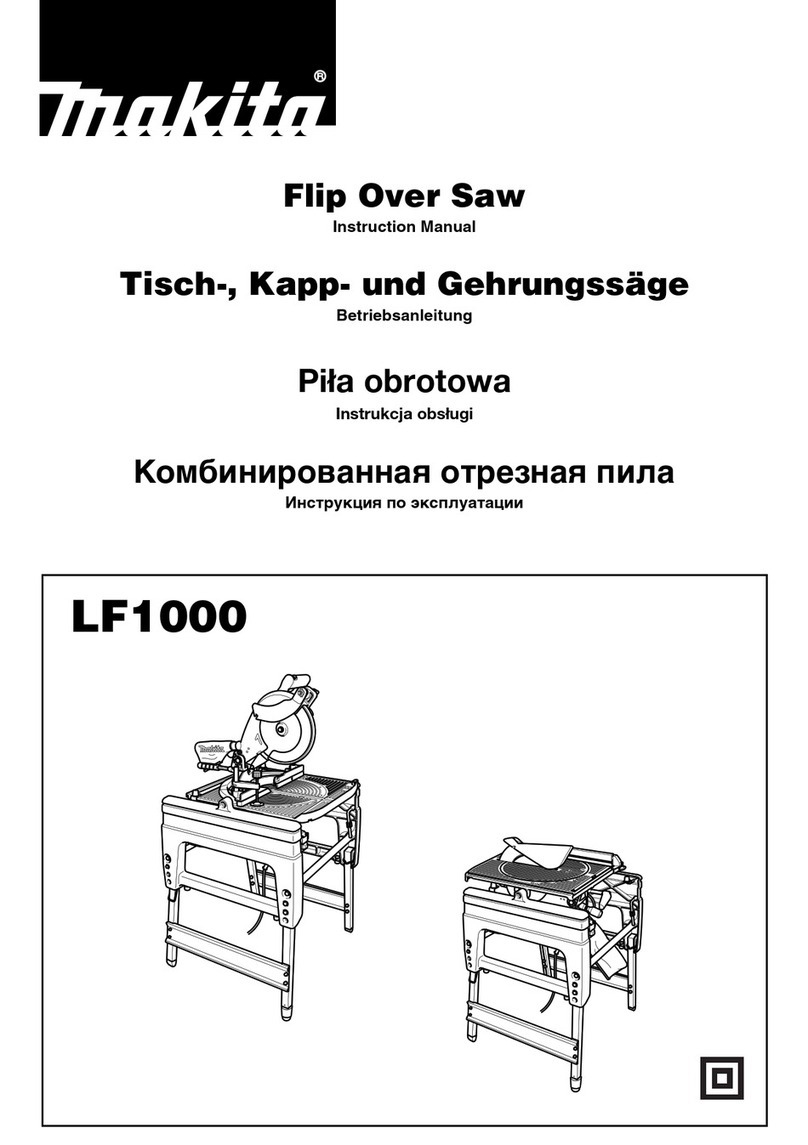
Makita
Makita LF1000 User manual
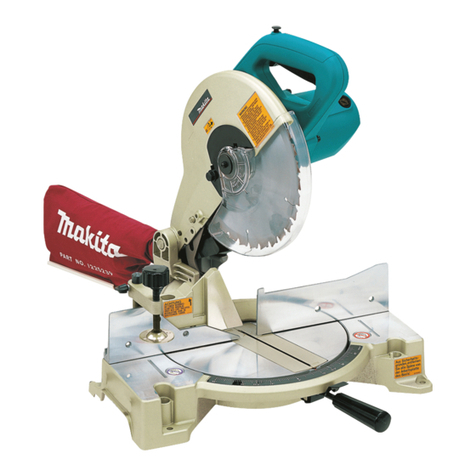
Makita
Makita LS1040 User manual
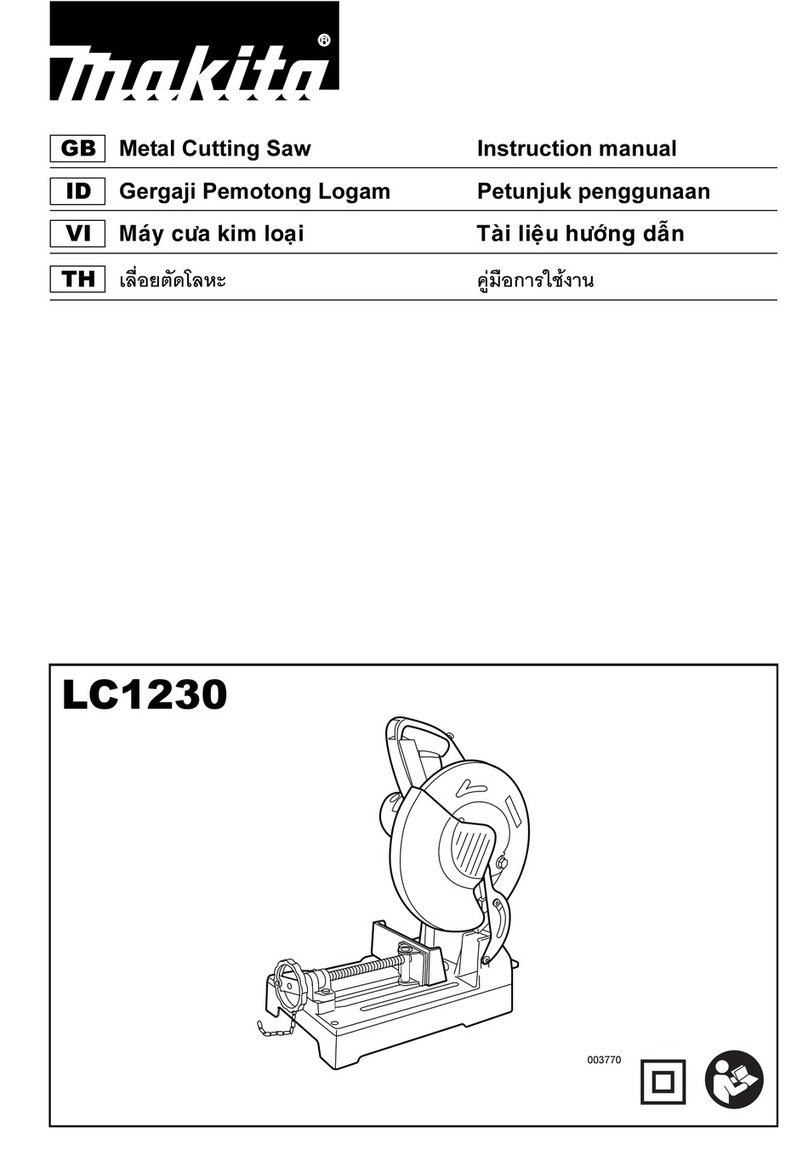
Makita
Makita LC1230 User manual
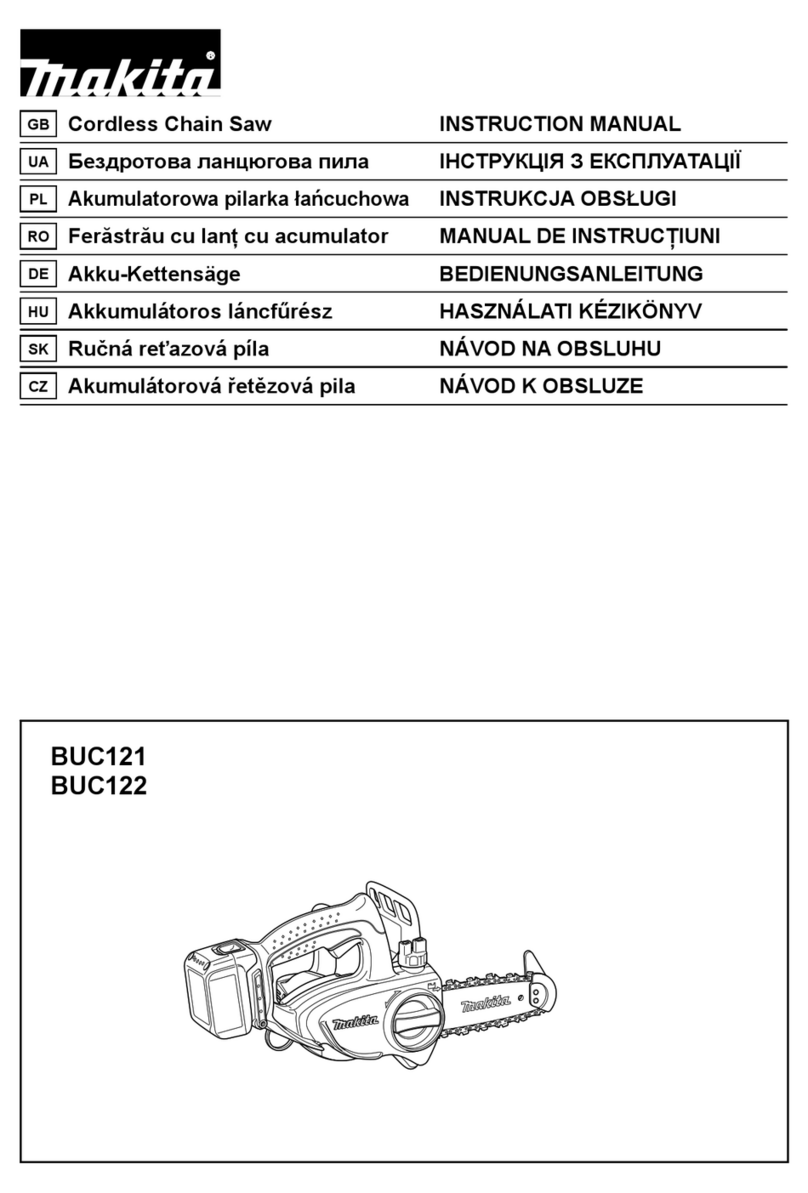
Makita
Makita BUC121 User manual

Makita
Makita DLS714 User manual
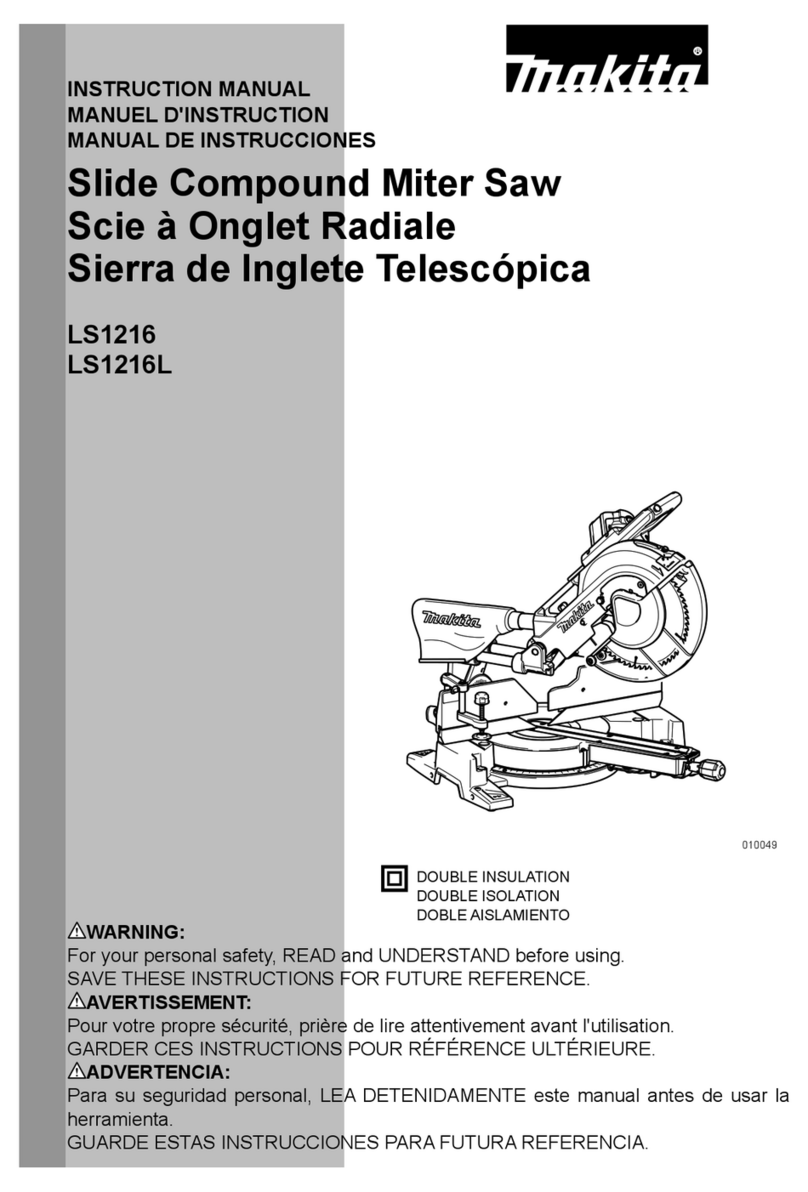
Makita
Makita LS1216 User manual
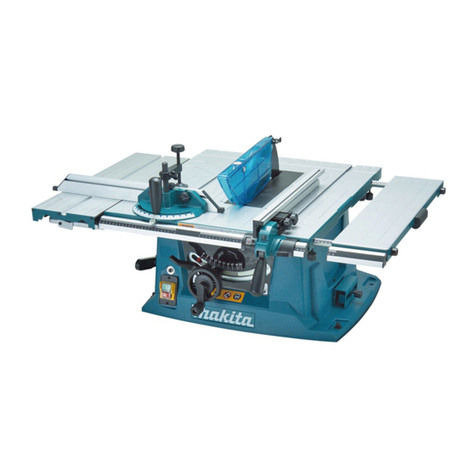
Makita
Makita MLT100 User manual

Makita
Makita 4200NH User manual
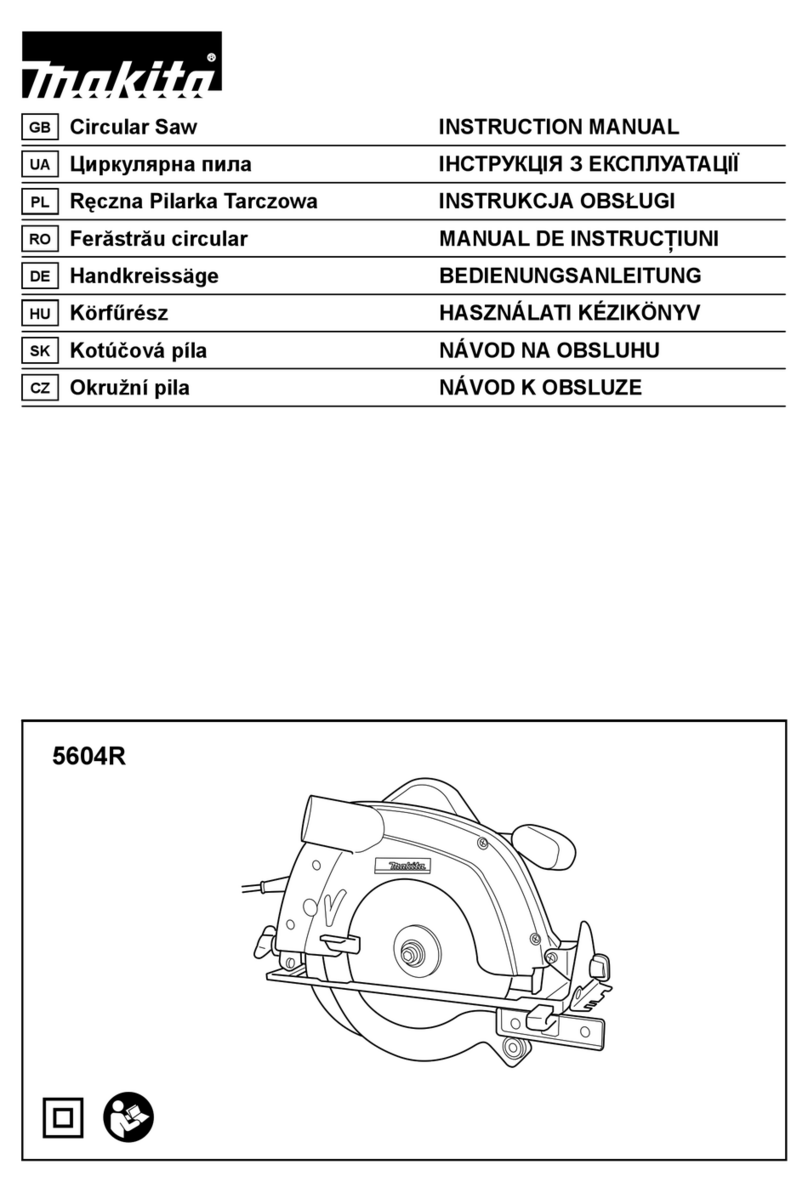
Makita
Makita 5604R User manual
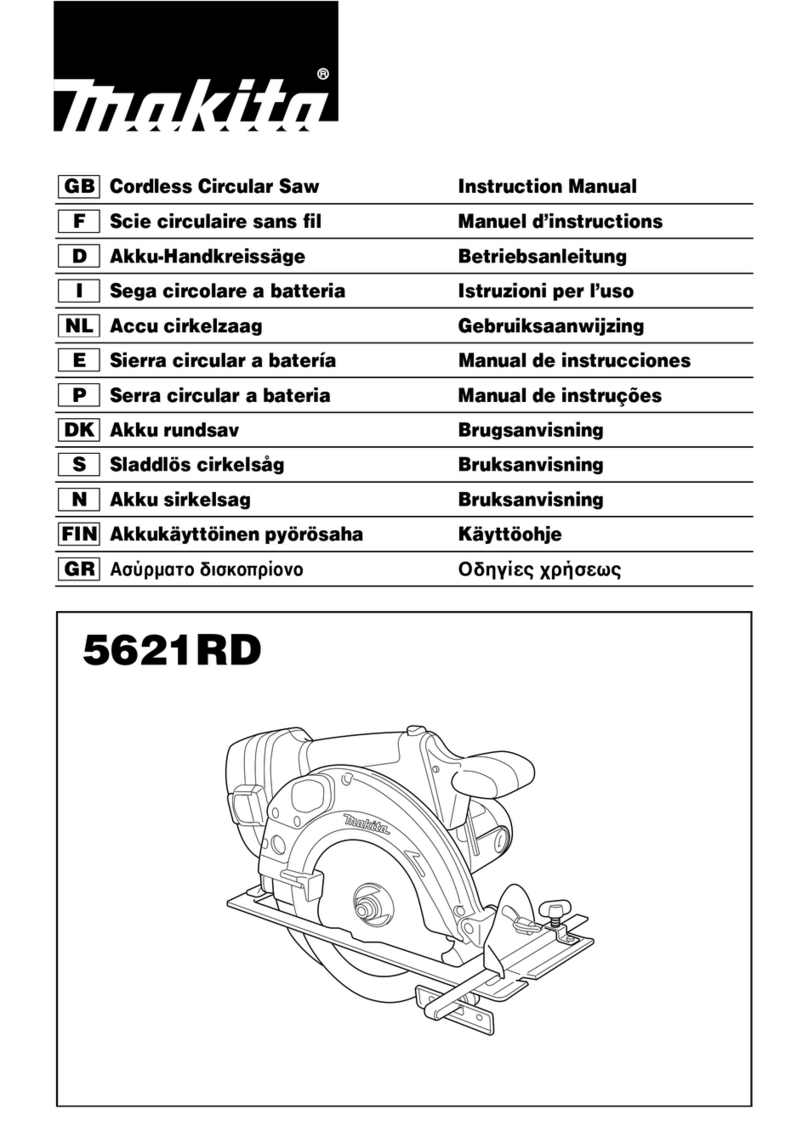
Makita
Makita 5621RD User manual
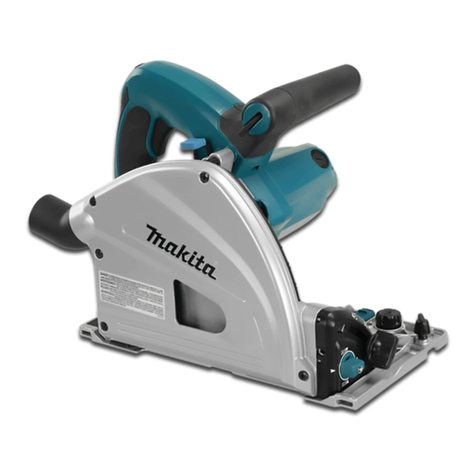
Makita
Makita SP6000 User manual

Makita
Makita 2702 User manual
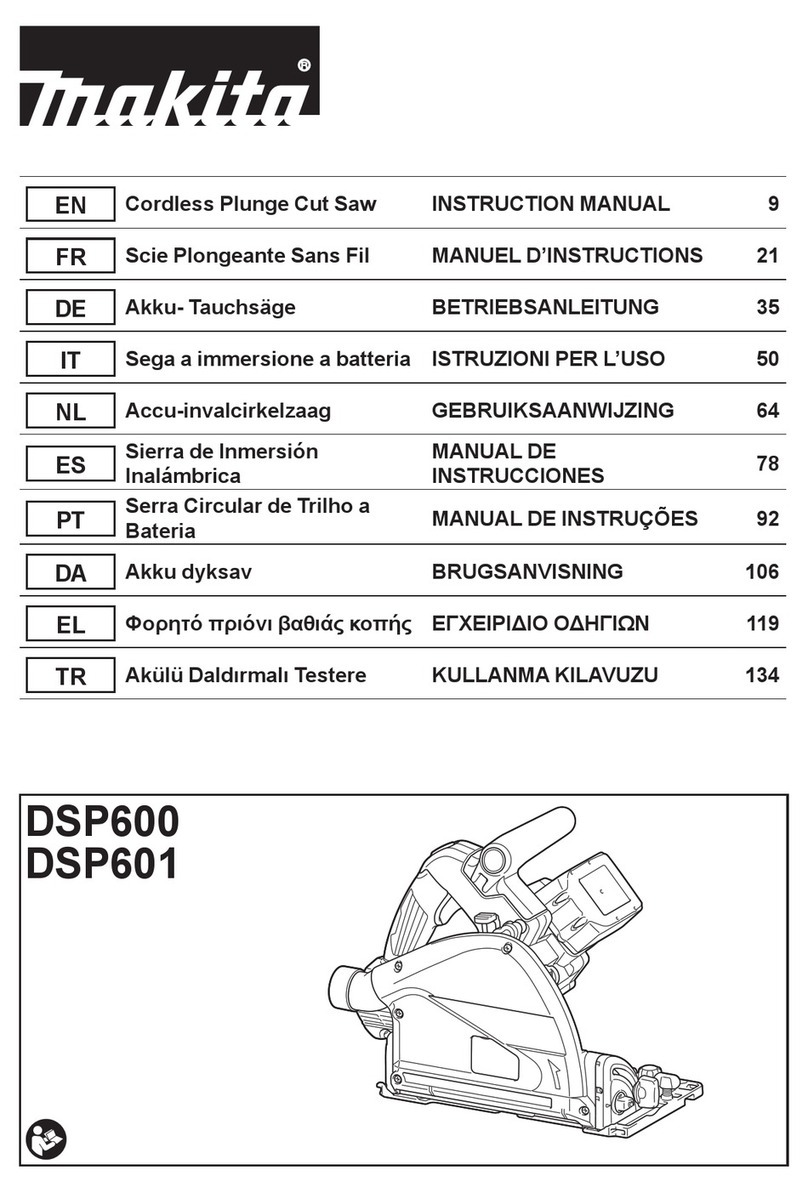
Makita
Makita DSP601ZJU2 User manual

Makita
Makita DPB181 Manual
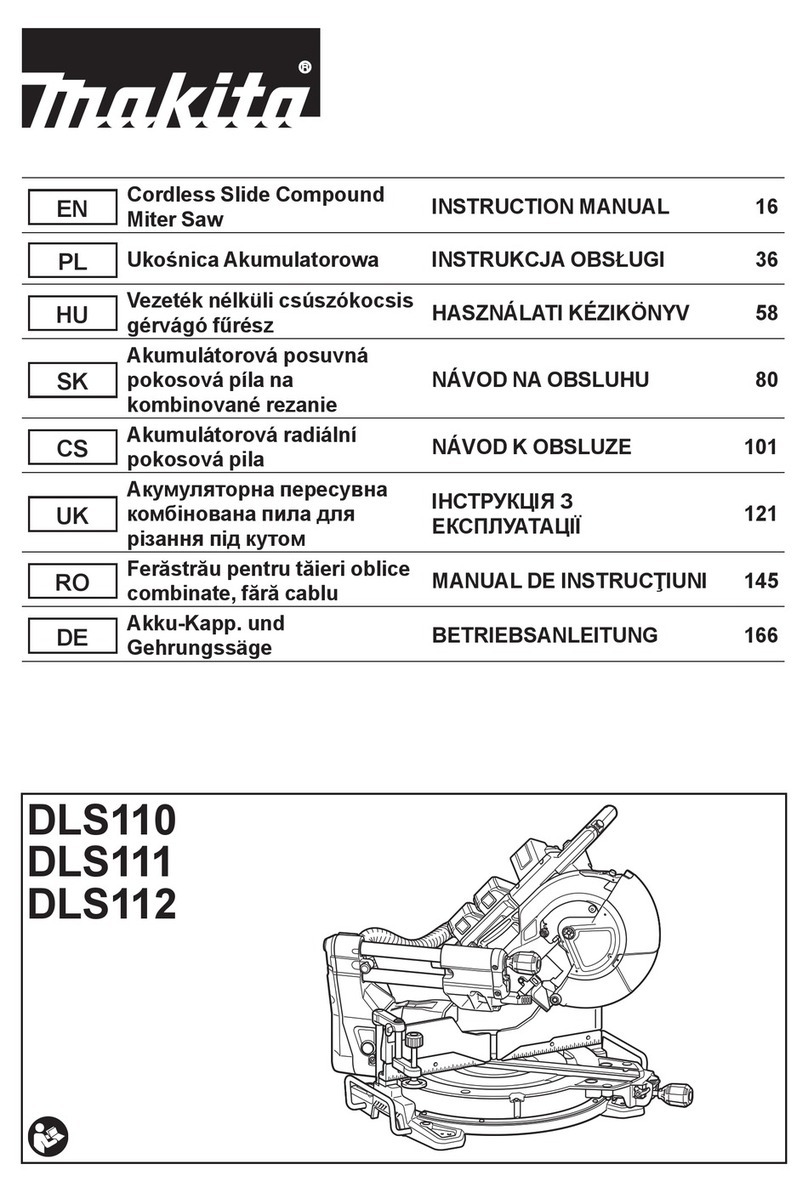
Makita
Makita DLS110 User manual

Makita
Makita XSS02 User manual
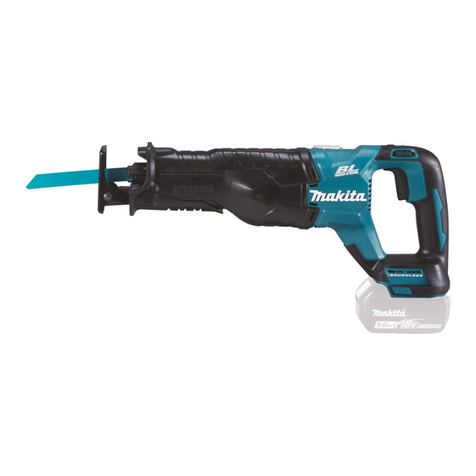
Makita
Makita DJR187 User manual

Makita
Makita RJ03 User manual
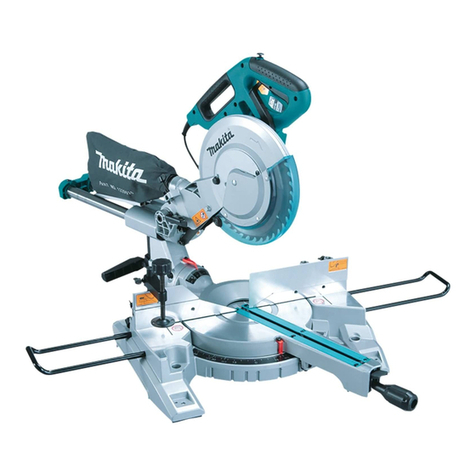
Makita
Makita LS1018 User manual

Makita
Makita M5802 User manual
